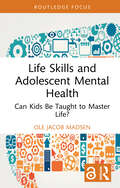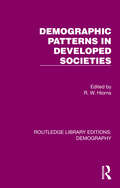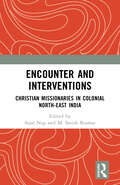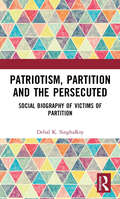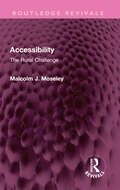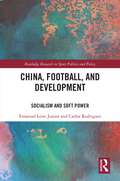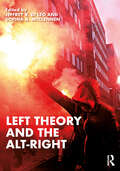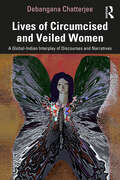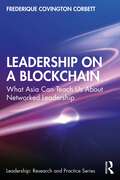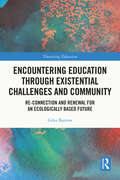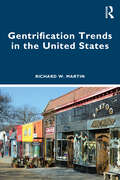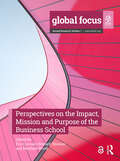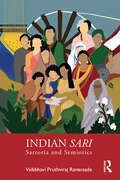- Table View
- List View
Life Skills and Adolescent Mental Health: Can Kids Be Taught to Master Life? (Routledge Focus on Mental Health)
by Ole Jacob MadsenCan school teach us to master life? This book confronts what the author sees as an ongoing trend in many Western democracies where citizens are increasingly being held accountable for their health and happiness. The author believes that the introduction of life skills in school shows a tendency to place more responsibility on the individual rather than address fundamental societal flaws that really should be solved politically. It examines how such responsibility to psychologically deal with these problems affects our mental health and quality of life. This book questions the fundamentals of the life mastery curriculum where we might be risking the creation of just another arena where children have to perform, challenging readers to evaluate more closely the premises, consequences and limitations of life mastery. The book, one of the first to question ‘life mastery’ as an achievable goal with critical reviews of the 21st century skills movement, will be of interest to psychologists, school counsellors, teachers, students, politicians, and any reader evaluating school curriculums in relation to the decline in youth and adolescent mental health.
Demographic Patterns in Developed Societies (Routledge Library Editions: Demography #7)
Originally published in 1980, this volume reviews the demographic patterns of fertility, marriage and mortality with reference to developed societies in the 19th and 20th centuries in Western Europe and North America. New (at the time of publication) data and methodology are considered and discussed, while maintaining the historical perspective.
Demographic Patterns in Developed Societies (Routledge Library Editions: Demography #7)
by R. W. HiornsOriginally published in 1980, this volume reviews the demographic patterns of fertility, marriage and mortality with reference to developed societies in the 19th and 20th centuries in Western Europe and North America. New (at the time of publication) data and methodology are considered and discussed, while maintaining the historical perspective.
Encounter and Interventions: Christian Missionaries in Colonial North-East India
The advent of colonialism and its associated developments has been characterized as one of the most defining moments in the history of South Asia. The arrival of Christian missionaries has not only been coeval to colonial rule, but also associated with development in the region. Their encounter, critique, endeavour and intervention have been very critical in shaping South Asian society and culture, even where they did not succeed in converting people. Yet, there is precious little space spared for studying the role and impact of missionary enterprises than the space allotted to colonialism. Isolated individual efforts have focused on Bengal, Madras, Punjab and much remains to be addressed in the context of the unique region of the North East India. In North East India, for example, by the time the British left, a majority of the tribals had abandoned their own faith and adopted Christianity. It was a socio-cultural revolution. Yet, this aspect has remained outside the scope of history books. Whatever reading material is available is pro-Christian, mainly because they are either sponsored by the church authorities or written by ecclesiastical scholars. Very little secular research was conducted for the hundred years of missionary endeavour in the region. The interpretations, which have emerged out of the little material available, are largely simplistic and devoid of nuances. This book is an effort to decenter such explanations by providing an informed historical and cultural appreciation of the role and contribution of missionary endeavors in British India.
Patriotism, Partition and the Persecuted: Social Biography of Victims of Partition
by Debal K. SinghaRoyThis book explores the theme of continuous wreaking of brutal persecution of a Hindu family on the one hand and the uncompromising efforts of Muslim friends and neighbours to protect this family on the other. It is set against the resultant and barbaric forces let loose after the propagation of the two nation theory, and the ultimate partition of India in 1947. Based on the soical biography of a Hindu family that stayed back in East Pakistan, it traces their journey, how they became 'other' in the country of their birth and faced persecution. This, being branded the other, led to part of the family migrating to Inida, away from their natal roots. The 1965 India-Pakistan war further brought prolonged separation and sufferings for these half-families living on both sides of the borders. Subjecting one to encounter helplessness, uncertainty and poverty in India, and the other to state sponsored apathy, coercion, arrests and physical tortures. The vicious atmosphere of violent communal aggression though did not stop their Muslim friends from protecting them. When the Muslim friend was killed by the religious fanatics in the newly liberated Bangladesh, the left behind member of the Hindu family realized that it was time to leave their motherland for India, where they died with the desire to go back to their motherland, buried along with them. Despite prolonged violence and tragic separation thereafter, numerous memories of the self-sacrificing efforts of the compatriots served as recollection in collective living in the Indian subcontinent.
Encounter and Interventions: Christian Missionaries in Colonial North-East India
by Sajal Nag M. Satish KumarThe advent of colonialism and its associated developments has been characterized as one of the most defining moments in the history of South Asia. The arrival of Christian missionaries has not only been coeval to colonial rule, but also associated with development in the region. Their encounter, critique, endeavour and intervention have been very critical in shaping South Asian society and culture, even where they did not succeed in converting people. Yet, there is precious little space spared for studying the role and impact of missionary enterprises than the space allotted to colonialism. Isolated individual efforts have focused on Bengal, Madras, Punjab and much remains to be addressed in the context of the unique region of the North East India. In North East India, for example, by the time the British left, a majority of the tribals had abandoned their own faith and adopted Christianity. It was a socio-cultural revolution. Yet, this aspect has remained outside the scope of history books. Whatever reading material is available is pro-Christian, mainly because they are either sponsored by the church authorities or written by ecclesiastical scholars. Very little secular research was conducted for the hundred years of missionary endeavour in the region. The interpretations, which have emerged out of the little material available, are largely simplistic and devoid of nuances. This book is an effort to decenter such explanations by providing an informed historical and cultural appreciation of the role and contribution of missionary endeavors in British India.
Patriotism, Partition and the Persecuted: Social Biography of Victims of Partition
by Debal K. SinghaRoyThis book explores the theme of continuous wreaking of brutal persecution of a Hindu family on the one hand and the uncompromising efforts of Muslim friends and neighbours to protect this family on the other. It is set against the resultant and barbaric forces let loose after the propagation of the two nation theory, and the ultimate partition of India in 1947. Based on the soical biography of a Hindu family that stayed back in East Pakistan, it traces their journey, how they became 'other' in the country of their birth and faced persecution. This, being branded the other, led to part of the family migrating to Inida, away from their natal roots. The 1965 India-Pakistan war further brought prolonged separation and sufferings for these half-families living on both sides of the borders. Subjecting one to encounter helplessness, uncertainty and poverty in India, and the other to state sponsored apathy, coercion, arrests and physical tortures. The vicious atmosphere of violent communal aggression though did not stop their Muslim friends from protecting them. When the Muslim friend was killed by the religious fanatics in the newly liberated Bangladesh, the left behind member of the Hindu family realized that it was time to leave their motherland for India, where they died with the desire to go back to their motherland, buried along with them. Despite prolonged violence and tragic separation thereafter, numerous memories of the self-sacrificing efforts of the compatriots served as recollection in collective living in the Indian subcontinent.
Accessibility: The Rural Challenge (Routledge Revivals)
by Malcolm J. MoseleyOriginally published in 1979, this book discusses the problem faced by planners, county councils, transport, health and education authorities as well as the inhabitants of rural Britain, of the inaccessibility of many areas of the UK. For certain sections of society such as the less well-off, children and teenagers and the elderly the impact is felt most strongly when local shops, schools and medical services are withdrawn in favour of larger units in distant towns. The book reviews the process of decline which led to this situation and considers the concept of accessibility to show how it can be developed into an analytical tool for measuring the success or failure of alternative policies. Each policy option is discussed in detail: the support of conventional bus or other transport services; the provision of mobile services; ‘mini-outlet’ policies and the long-term restructuring of the rural settlement pattern.
Accessibility: The Rural Challenge (Routledge Revivals)
by Malcolm J. MoseleyOriginally published in 1979, this book discusses the problem faced by planners, county councils, transport, health and education authorities as well as the inhabitants of rural Britain, of the inaccessibility of many areas of the UK. For certain sections of society such as the less well-off, children and teenagers and the elderly the impact is felt most strongly when local shops, schools and medical services are withdrawn in favour of larger units in distant towns. The book reviews the process of decline which led to this situation and considers the concept of accessibility to show how it can be developed into an analytical tool for measuring the success or failure of alternative policies. Each policy option is discussed in detail: the support of conventional bus or other transport services; the provision of mobile services; ‘mini-outlet’ policies and the long-term restructuring of the rural settlement pattern.
China, Football, and Development: Socialism and Soft Power (Routledge Research in Sport Politics and Policy)
by Emanuel Leite Junior Carlos RodriguesThis book uses football as a lens through which to examine China’s economic development, its political economy, and its political thought. Focusing on the Chinese Football Development Plan, the book opens up new perspectives on the concepts of hegemony, soft power, socialism with Chinese characteristics, and China’s rise to the position of geopolitical superpower. Presenting a critical Marxist analysis of ‘soft power’, and drawing on Gramsci’s conceptualisation of hegemony, the book argues that football can be seen as a resource for seduction and persuasion, and therefore as an instrument to be used in the ‘hegemonic clash’. Reflecting on the idea of soft power in relation to imperialism and ideology, and standing in contrast to prevailing Western orthodox analyses of Chinese development, this book shows how the ‘Chinese Football Dream’ is a significant component of the ‘Chinese Dream’ of ‘rejuvenation of the nation’, and shows how football can help us to better understand the role of the state as an inducer of development and creative destruction. This is fascinating reading for anybody with an interest in sport policy, public policy, sport and society, football, development studies, political economy, or political thought.
China, Football, and Development: Socialism and Soft Power (Routledge Research in Sport Politics and Policy)
by Emanuel Leite Junior Carlos RodriguesThis book uses football as a lens through which to examine China’s economic development, its political economy, and its political thought. Focusing on the Chinese Football Development Plan, the book opens up new perspectives on the concepts of hegemony, soft power, socialism with Chinese characteristics, and China’s rise to the position of geopolitical superpower. Presenting a critical Marxist analysis of ‘soft power’, and drawing on Gramsci’s conceptualisation of hegemony, the book argues that football can be seen as a resource for seduction and persuasion, and therefore as an instrument to be used in the ‘hegemonic clash’. Reflecting on the idea of soft power in relation to imperialism and ideology, and standing in contrast to prevailing Western orthodox analyses of Chinese development, this book shows how the ‘Chinese Football Dream’ is a significant component of the ‘Chinese Dream’ of ‘rejuvenation of the nation’, and shows how football can help us to better understand the role of the state as an inducer of development and creative destruction. This is fascinating reading for anybody with an interest in sport policy, public policy, sport and society, football, development studies, political economy, or political thought.
Left Theory and the Alt-Right
by Jeffrey R. Di Leo Sophia A. McclennenThe alt-right movement in the United States has actively been endorsing the use of left theory to achieve its ends—and with varying degrees of success. Tracing occasions where figures on the alt-right reference left theory, this volume asks if the alt-right’s reference of left theory is just bad reading, or are there troubling ways that certain types of left theory encourage such interpretations? What if the connections between left theory and the alt-right lie in the shared disdain for certain types of institutions, structures of power, and the status quo? Are there lessons to be learned in what can often appear as an overlapping desire to deconstruct concepts like truth, justice, freedom, and democracy? Drawing on the longer history of right-wing readings of left theory, this volume seeks to unpack these recent developments and consider their impact on the future of theory.
Left Theory and the Alt-Right
by Di Leo, Jeffrey R. Sophia A. McClennenThe alt-right movement in the United States has actively been endorsing the use of left theory to achieve its ends—and with varying degrees of success. Tracing occasions where figures on the alt-right reference left theory, this volume asks if the alt-right’s reference of left theory is just bad reading, or are there troubling ways that certain types of left theory encourage such interpretations? What if the connections between left theory and the alt-right lie in the shared disdain for certain types of institutions, structures of power, and the status quo? Are there lessons to be learned in what can often appear as an overlapping desire to deconstruct concepts like truth, justice, freedom, and democracy? Drawing on the longer history of right-wing readings of left theory, this volume seeks to unpack these recent developments and consider their impact on the future of theory.
Lives of Circumcised and Veiled Women: A Global-Indian Interplay of Discourses and Narratives
by Debangana ChatterjeeThe book unravels the politics of representation and the process of exoticising women’s bodies through the prism of external gaze and knowledge production. It brings out the intricacies of representational discourses around cultural practices of female circumcision (FC)/female genital cutting (FGC) and Islamic veiling. Focusing on crucial international legal texts and national legislation, the book gives an overview of the cultural nuances in FC/FGC and juxtaposes it with the Indian variation, khafz. The author studies the international veiling narratives that conjure up a fractured discourse containing aspects of colonialism, Islamophobia, and Islamic fashion and maps them with the regional variations of Islamic purdah in India. The volume explores the cultural practice of khafz and purdah through narratives in India, portraying how representational factors from international discourses reflect on the Indian context and vice versa. Amid the world of binaries and polarised opinions, the book offers a nuanced analysis of the space in-between, characterised by narratives from women. By situating women’s narratives in relation to family, community, state, and international politics, the book explores the global-Indian interplay of discourses on FC/FGC and Islamic veiling. This volume will be of interest to scholars, students, and readers of gender studies, feminism, cultural and religious studies, sociology, South Asian studies, and International Relations.
Lives of Circumcised and Veiled Women: A Global-Indian Interplay of Discourses and Narratives
by Debangana ChatterjeeThe book unravels the politics of representation and the process of exoticising women’s bodies through the prism of external gaze and knowledge production. It brings out the intricacies of representational discourses around cultural practices of female circumcision (FC)/female genital cutting (FGC) and Islamic veiling. Focusing on crucial international legal texts and national legislation, the book gives an overview of the cultural nuances in FC/FGC and juxtaposes it with the Indian variation, khafz. The author studies the international veiling narratives that conjure up a fractured discourse containing aspects of colonialism, Islamophobia, and Islamic fashion and maps them with the regional variations of Islamic purdah in India. The volume explores the cultural practice of khafz and purdah through narratives in India, portraying how representational factors from international discourses reflect on the Indian context and vice versa. Amid the world of binaries and polarised opinions, the book offers a nuanced analysis of the space in-between, characterised by narratives from women. By situating women’s narratives in relation to family, community, state, and international politics, the book explores the global-Indian interplay of discourses on FC/FGC and Islamic veiling. This volume will be of interest to scholars, students, and readers of gender studies, feminism, cultural and religious studies, sociology, South Asian studies, and International Relations.
Leadership on a Blockchain: What Asia Can Teach Us About Networked Leadership (Leadership: Research and Practice)
by Frederique Covington CorbettLeadership on a Blockchain: What Asia Can Teach Us About Networked Leadership is an authoritative text that goes to the foremost digitally connected markets of the world in Asia, and accounts for how leaders and teams are exercising leadership Darwinism to adapt for agility and connectivity. The book begins by offering a contextual grounding for new leadership ideas to emerge. It contends that a "new geography of leadership" is unfolding as the world shifts away from unified globalist ideology and a dominant Western view of leadership. It moves on to describe how Asia is uniquely placed to become the leadership sandbox for the future. It accounts for how leaders and teams are exercising leadership Darwinism to adapt for agility and connectivity. To facilitate learning for the readers, this book includes creatives features such as the following: An abbreviated history of significant leadership milestones in the last century A leadership manifesto for the digital age A practitioners’ starter kit to reimagining leadership in their organizations. Leaving behind the typical discourse of leadership anchored in power, control, and hierarchy, it offers a provocative call to all businesspeople to apply the principles of one of the most innovative technologies – blockchain – to reimagine leadership for transparency, trust, and distributed decision-making. The book concludes by distilling critical lessons for global leaders to take forward and lead a revolution in their own organizations. Sharing first-person accounts from leaders and their teams in China, Singapore, India, and Indonesia, and combining this with insights from the author’s own research, Leadership on a Blockchain will be of use to leaders around the world looking to transform their own leadership. It will also be of interest to academics and students of leadership, change management, organizational behavior, and cultural studies.
Leadership on a Blockchain: What Asia Can Teach Us About Networked Leadership (Leadership: Research and Practice)
by Frederique Covington CorbettLeadership on a Blockchain: What Asia Can Teach Us About Networked Leadership is an authoritative text that goes to the foremost digitally connected markets of the world in Asia, and accounts for how leaders and teams are exercising leadership Darwinism to adapt for agility and connectivity. The book begins by offering a contextual grounding for new leadership ideas to emerge. It contends that a "new geography of leadership" is unfolding as the world shifts away from unified globalist ideology and a dominant Western view of leadership. It moves on to describe how Asia is uniquely placed to become the leadership sandbox for the future. It accounts for how leaders and teams are exercising leadership Darwinism to adapt for agility and connectivity. To facilitate learning for the readers, this book includes creatives features such as the following: An abbreviated history of significant leadership milestones in the last century A leadership manifesto for the digital age A practitioners’ starter kit to reimagining leadership in their organizations. Leaving behind the typical discourse of leadership anchored in power, control, and hierarchy, it offers a provocative call to all businesspeople to apply the principles of one of the most innovative technologies – blockchain – to reimagine leadership for transparency, trust, and distributed decision-making. The book concludes by distilling critical lessons for global leaders to take forward and lead a revolution in their own organizations. Sharing first-person accounts from leaders and their teams in China, Singapore, India, and Indonesia, and combining this with insights from the author’s own research, Leadership on a Blockchain will be of use to leaders around the world looking to transform their own leadership. It will also be of interest to academics and students of leadership, change management, organizational behavior, and cultural studies.
Encountering Education through Existential Challenges and Community: Re-connection and Renewal for an Ecologically based Future (Theorizing Education)
by Giles BarrowDirectly inspired by Indian British activist Satish Kumar’s 2013 seminal work ‘Soil, Soul and Society’, this book rethinks education in line with thoughts around the current climate crisis, the purpose of education in a post-pandemic world, and the mental health of children, teachers and youth across societies. Acknowledging the realities of a world battling with the after effects of COVID-19, the author envisions a future for education that realises real-world solutions to contemporary existential, ecological and societal challenges that might otherwise be limited to an imaginary or idealist space. Offering a novel approach through a combination of narrative-based inquiry and auto-ethnographic study, the book provides a synthesis of ideas from both Kumar and political philosopher Hannah Arendt not usually linked to debates in sustainability education. Ultimately providing a critique of a predominantly Western-orientated, global education movement, this interdisciplinary book will appeal to scholars, researchers, and post-graduate students involved in education theory and the philosophy of education, as well as indigenous and sustainability education more broadly.
Encountering Education through Existential Challenges and Community: Re-connection and Renewal for an Ecologically based Future (Theorizing Education)
by Giles BarrowDirectly inspired by Indian British activist Satish Kumar’s 2013 seminal work ‘Soil, Soul and Society’, this book rethinks education in line with thoughts around the current climate crisis, the purpose of education in a post-pandemic world, and the mental health of children, teachers and youth across societies. Acknowledging the realities of a world battling with the after effects of COVID-19, the author envisions a future for education that realises real-world solutions to contemporary existential, ecological and societal challenges that might otherwise be limited to an imaginary or idealist space. Offering a novel approach through a combination of narrative-based inquiry and auto-ethnographic study, the book provides a synthesis of ideas from both Kumar and political philosopher Hannah Arendt not usually linked to debates in sustainability education. Ultimately providing a critique of a predominantly Western-orientated, global education movement, this interdisciplinary book will appeal to scholars, researchers, and post-graduate students involved in education theory and the philosophy of education, as well as indigenous and sustainability education more broadly.
Gentrification Trends in the United States
by Richard W. MartinGentrification Trends in the United States is the first book to quantify the changes that take place when a neighborhood’s income level, educational attainment, or occupational makeup outpace the city as a whole – the much-debated yet poorly understood phenomenon of gentrification. Applying a novel method to four decades of U.S. Census data, this resource for students and scholars provides a quantitative basis for the nuanced demographic trends uncovered through ethnography and other forms of qualitative research. This analysis of a rich data source characterized by a broad regional and chronological scope provides new insight into larger questions about the nature and prevalence of gentrification across the United States. Has gentrification become more common over time? Which cities have experienced the most gentrification? Is gentrification widespread, or does it tend to be concentrated in a small number of cities? Has the nature of gentrification changed over time? Ideal reading for courses in real estate, urban planning, urban economics, sociology, geography, econometrics, and GIS, this pathbreaking addition to the urban studies literature will enrich the perspective of any scholar of U.S. cities.
Perspectives on the Impact, Mission and Purpose of the Business School (EFMD Management Education)
With contributions from some of the leading thinkers in business school education, this book explores the impact and purpose of the business school, and addresses some of the most important questions facing management education today. The diverse perspectives brought together by the EFMD in this volume examine a number of common questions, themes and challenges. These include: whether business schools should be viewed as schools of management, given the complexity of the business environment; what is the positive impact of business school research, and the balance of relevant, practical impact and academic rigour; the strategic evolution of business schools and how they may evolve in a more purposeful direction; and why business school leaders compete strongly but are reluctant to collaborate, and how collaboration may encourage greater positive societal impact. With insightful commentary and illustrative case studies, this book serves as a landmark publication on the value and impact of business schools. The book will be of particular interest to those working in business schools, higher education leaders, policy makers and business leaders seeking insight into the value, impact and future of business and management education.
Gentrification Trends in the United States
by Richard W. MartinGentrification Trends in the United States is the first book to quantify the changes that take place when a neighborhood’s income level, educational attainment, or occupational makeup outpace the city as a whole – the much-debated yet poorly understood phenomenon of gentrification. Applying a novel method to four decades of U.S. Census data, this resource for students and scholars provides a quantitative basis for the nuanced demographic trends uncovered through ethnography and other forms of qualitative research. This analysis of a rich data source characterized by a broad regional and chronological scope provides new insight into larger questions about the nature and prevalence of gentrification across the United States. Has gentrification become more common over time? Which cities have experienced the most gentrification? Is gentrification widespread, or does it tend to be concentrated in a small number of cities? Has the nature of gentrification changed over time? Ideal reading for courses in real estate, urban planning, urban economics, sociology, geography, econometrics, and GIS, this pathbreaking addition to the urban studies literature will enrich the perspective of any scholar of U.S. cities.
Perspectives on the Impact, Mission and Purpose of the Business School (EFMD Management Education)
by Eric Cornuel Howard Thomas Matthew WoodWith contributions from some of the leading thinkers in business school education, this book explores the impact and purpose of the business school, and addresses some of the most important questions facing management education today. The diverse perspectives brought together by the EFMD in this volume examine a number of common questions, themes and challenges. These include: whether business schools should be viewed as schools of management, given the complexity of the business environment; what is the positive impact of business school research, and the balance of relevant, practical impact and academic rigour; the strategic evolution of business schools and how they may evolve in a more purposeful direction; and why business school leaders compete strongly but are reluctant to collaborate, and how collaboration may encourage greater positive societal impact. With insightful commentary and illustrative case studies, this book serves as a landmark publication on the value and impact of business schools. The book will be of particular interest to those working in business schools, higher education leaders, policy makers and business leaders seeking insight into the value, impact and future of business and management education.
Indian Sari: Sartoria and Semiotics
by Vaibbhavi Pruthviraj RanavaadeThe sari has remained an essential part of culture, tradition and fashion in South Asia and India through many centuries. This book examines the variety of meanings which it carries as a symbol of Indian femininity and tradition as well as a means of creative fashion expression for modern India. It discusses the semiotic interpretations of the sari today by understanding its significance for traditional weavers, designers and people who wear saris at home, work or for religious or cultural occasions. Through surveys, interactions and interviews, the author explores the shared experience of wearing saris in different social and cultural settings across economic groups in farms and boardrooms as well as a means of creative expression for young Indians. It also looks at the processes involved in making traditional saris today, draping and weaving styles, buying behaviour, saris in pop-culture, pride parades and Bollywood and interpretations of what the sari signifies in different socio-economic circles in India. This book will be of interest to students of fashion, design, fashion business, history and cultural studies. It will also be useful for professionals working in the fashion industry and designers.
Indian Sari: Sartoria and Semiotics
by Vaibbhavi Pruthviraj RanavaadeThe sari has remained an essential part of culture, tradition and fashion in South Asia and India through many centuries. This book examines the variety of meanings which it carries as a symbol of Indian femininity and tradition as well as a means of creative fashion expression for modern India. It discusses the semiotic interpretations of the sari today by understanding its significance for traditional weavers, designers and people who wear saris at home, work or for religious or cultural occasions. Through surveys, interactions and interviews, the author explores the shared experience of wearing saris in different social and cultural settings across economic groups in farms and boardrooms as well as a means of creative expression for young Indians. It also looks at the processes involved in making traditional saris today, draping and weaving styles, buying behaviour, saris in pop-culture, pride parades and Bollywood and interpretations of what the sari signifies in different socio-economic circles in India. This book will be of interest to students of fashion, design, fashion business, history and cultural studies. It will also be useful for professionals working in the fashion industry and designers.
